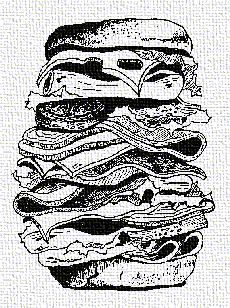Note: This site is moving to KnowledgeJump.com. Please reset your bookmark.
ADDIE Is Like Building A Deli Sandwich
Using ADDIE or ISD (Instructional System Development) to create a learning or training process is similar to building a sandwich. In one process you create a sandwich, in another you create training. When some people see or hear the word system, they think of mega-methodologies. However, ISD is simply a common sense approach to training. It does this by Analyzing the problem, Designing a specification, Developing the courseware, Implementing the solution, and performing Evaluations throughout the process (ADDIE).
Analysis
Jumping straight into developing a learning process is the same as heading for the deli to buy something nutritional and ending up at the candy shop buying junk-food. If you do not analyze the problem, you might end up with junk-training, which is just like junk-food — it provides no nutritional value and too much of it is harmful. Just as it requires some study to find out what food is really healthy for you, it requires some study to find the real cause of a performance problem.
The analysis phase is simply gaining an understanding of the problem and determining the scope of the project before you attempt to solve it. In some cases it will require a few hours of thought and research, while complex cases might require several weeks of intense research.
The end result should be a well thought out and researched goal that is result driven. This ensures that the training will have a positive impact upon the organization.
Design
The design and development phase can be thought of as the deli sandwich. First comes the objectives, which is top layer of bread, and then the tests, which is the bottom layer of bread. You then decide the type of meats, vegetables, and cheeses that will go in your sandwich (the performance steps). In the development phase, you will actually add the meat, cheese and various condiments. Just as you start building a sandwich with two slices of bread (the beginning and the end), you start the design and development by building the beginning (objectives) and the end (tests).
The Learning Objectives
The Learning Objectives tell you what should be taking place upon completion of the training. In some cases you will be using dark rye bread by building Tasks, Conditions, and Standards (Robert Mager's Learning Objectives); while in other cases you want a lighter wheat bread by building simple goals. Normally, complex training solutions require Learning Objectives, while training solutions that are more educational or developmental in nature might only require simple goals.
The Tests
Testing ensures that the objectives or goals are accomplished. Again, sometimes you want a heavy dark bread and will build hands-on performance tests or written tests, while at other times you want home-style bread and will simply check the learners when they return to the workplace. But in any case, there is no use wasting your time building a solution if you are not going to measure it in some way. At the very least drop in on them at the workplace to see how the training has impacted their performance. . . anything less is uncivilized.
The Performance Steps
The performance steps or learning steps is the basic outline that gets you from one layer of bread to the next. That is, you have your objectives (top layer of bread); then you have the various performance steps (meat and cheeses); and on the other end is the test (bottom layer of bread).
Noticed how the training program is started by identifying the outcomes — the learning objectives. They tell you what must be done while the tests describe how the outcomes will be verified, and finally the steps guide you in getting from the objectives to successful test completion.
Develop
Development goes hand in hand with Design. By performing the design phase first — the outcomes, you simplify the developmental process. It is much easier to build solutions when you know the desired outcome. Development is simply cutting and layering the vegetables, meat, and cheeses according to plans. This can be thought of as the instructional methods. You also add various fillings or condiments (things that add spice and crunch) that makes for not only a nutritional sandwich, but one which is also tasty to eat. Learning is the same way ... you can develop instruction, but if it is not "tasty" to the learners, they will not consume it.
Implement
It is now time to eat the sandwich (yes!) — the instruction is implemented.

Evaluation
Note that the evaluation, while traditionally discussed last, is actually performed throughout the process. When building a sandwich, you check each ingredient to ensure it is fresh and wholesome. You do not knowingly put spoiled meat or rotten lettuce in it and hope it turns out OK. Evaluating ISD is the same. You should not spend all that time building a solution, and then waiting until the end to see if it works.
You evaluate in the analysis phase by determining if it really is a training problem. You also evaluate to see if there is a similar solution (no need to reinvent the wheel). In the design phase, the objectives are evaluated through the tests. That is, do the performance steps logical link the objectives and the tests together. The development phase has no built in evaluations, but you could perform iteration (prototyping) by using a developing-implement-evaluate-developing-implement-evaluate-etc type of approach. Or at the very least having another instructional design specialist check your solutions.
The implementation is the final testing ground. Sometimes you might have to add a side-dish (another performance solution) or another sandwich (more training) or change the ingredients (meet the learners expectations) to complete the nutritional void (performance gap).



